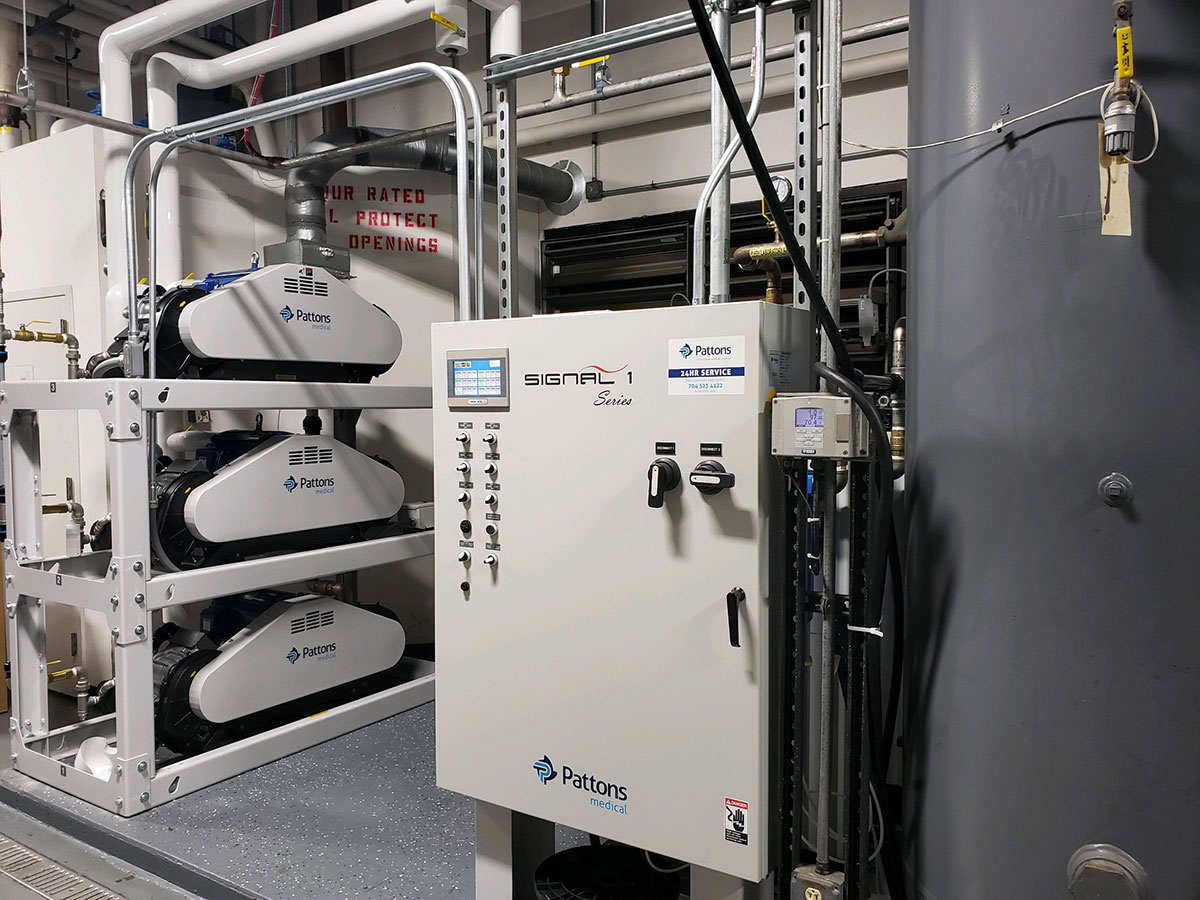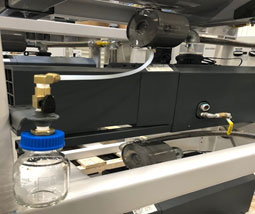MOST COMMONLY ASKED MEDICAL AND LABORATORY GAS QUESTIONS
Our Pattons Medical team brings to the table a combined expertise of 400+ years in the medical and laboratory gas solutions industry. We want to share this wealth of knowledge to help you feel more confident in your line of work. Pattons Medical has consulted with some of our most knowledgeable subject manner experts to answer some of the most commonly asked medical and laboratory gas questions. You can also watch our "Ask The Experts – Live Q&A," webinar recording on our website, along with all past webinars.
Does Pattons Medical provide parts for all medical gas systems or only Pattons Medical? What do I need to provide to get comparative parts pricing?
Pattons Medical provides part numbers for all systems by crossing numbers over. Pattons Medical also has a Master Cross Reference Guide available on our website to help you determine what parts are required and to assist with crossing over to our part numbers. If there were an event where we cannot find the part, we recommend that you send your consultant a picture and the original part number so that we are able to cross it over.
Why is a 3-ball valve bypass around the receiver needed?
Within the 3-valve bypass, the bypass itself is mandatory by NFPA 99 code. Pattons Medical does a 3-valve bypass on most of our system. It is most important with air systems because it allows the air to go through the receiver. In the receiver, the air will drop out any condensation and will also lower the air temperature while it’s going through there, which helps the dryer be more efficient.
Another point on air systems, it acts as a storage capacity which will allow the compressors to cycle less, meaning they will run longer but cycle less, which is better for the equipment. On vacuum systems, it’s not as critical, although you need to have a bypass.
For more information, you can view the specifications sheets located throughout our website.
Can I put a shut-off valve on the vacuum exhaust?
Pattons Medical does not recommend a valve on the exhaust, but some engineers do spec it. If you do put a valve on the exhaust of a vacuum, we recommend putting a hole in the valve, so that there is some kind of marker, but the valve needs to remain open.
If the valve is closed, the equipment could be damaged; it could trip the overload, and ultimately, you could lose the vacuum. Therefore, it is very important that it remains open while in service.
Where are the sensors placed for operating room area alarm panels?
First, you can have it local to the alarm panel at the nurse’s station, sitting in the wall.
Secondly, you can have it “remote,” placing it on top of the pipe, within the ceiling. However, keep in mind, it will need to be annually verified visually by the person completing annual evaluations in the facility.
The third method is more common practice; you can place the sensor in the zone valve box itself so that it’s easy to maintain if it ever needs to be changed out or annually visually inspected. An important thing to remember is that it goes on the patient side of the zone valve.
Is there a benefit in using open scroll systems vs closed systems?
Pattons Medical does not offer enclosed scroll systems. The reason for this is because enclosed scrolls have a higher ambient temperature inside of the cabinet itself, meaning you have to estimate about 10 degrees higher than the outside temperature, so you’re losing ambient temperature usage. You would need to have an air-conditioned room. Another reason is that with enclosed, your aftercooler is also in there, so you are blowing the increased ambient air across your aftercooler.
Therefore, instead of getting a 15-degree temperature rise on your air before the dryer, it will be 25 degrees because you can’t cool it due to the increased air temperature. A final reason is due to service. Inside an enclosed scroll, you may have to remove panels and do more work around unlike the simplicity of our open frame systems. With Pattons Medical open frames, we find that there is a lot more flexibility that we are able to provide the customer. Not all of our systems are cut-and-dry standard systems. Often times, we will do little modifications based on where the equipment is being installed. With an open system, we have that opportunity. We do not offer or recommend closed systems.

Are auxiliary valves required for source equipment?
Auxiliary valves are not required per code, but Pattons Medical does recommend them. They have many uses if you experience any equipment failure. Auxiliary valves give you a spot to hook up temporary equipment. Suppose you are doing an expansion or inputting new equipment. In that case, auxiliary valves allow you to connect pipe into it without shutting down the existing pipeline to put in a new connection. They provide flexibility for future events that you may not foresee today.
Does Pattons Medical have master specifications?
Pattons Medical offers Master Specification Guidelines on our website. When it comes time for a project and you are viewing different vacuum technologies, we use blue italics for any place you will need to make a choice. From there, you will go in and pick which technology you want for said project.
Pattons Medical also has a webinar called Creating a Strong Medical Gas Specification. Within that webinar, we broke down the specifications, section by section, with some specific topics that sometimes get missed on a job. Your local consultant will also be more than happy to come in and present live at your location.
What is the design process from site surveys to drawings to final handovers?
A brief overview is that the first thing a facility does when they decide to build, expand, or remodel, is hire an architect. The architect will put together some drawings of the building, shelf space, and other details. Then, they will hire the mechanical, electrical, and plumbing engineer. The medical gas design takes place most of the time by the plumbing designer. From there, you would have to start looking at outlet counts, where they are needed and begin sizing. It’s important to try to have a list of questions that can almost apply to any project to give to an owner when you have the opportunity. Then, you can start the design process of laying and sizing the pipe, sizing the source equipment, and going through revisions before you get to construction. After this, you’ll go through getting submittals from the contractor, and making sure your specifications have come in.
Where can I find the breaker sides for Pattons Medical systems?
Pattons Medical does not provide the breaker sides for the system, as in the main breaker bringing power into the system itself. However, we do provide the full load AMP for our systems, this is on the bottom of the spec page. Each spec page has a full load AMP rating for each voltage. We also provide that on the electrical schematics for when the electrical contractor is wiring up the system. The safety of the master breaker is up to the installing electrician but we do give out information regarding that. We can offer assistance with safety measures anytime they call in.
Can we retrofit a variable frequency drive onto a medical vacuum system?
For claw vacuums, Pattons Medical can provide retrofit panels. Our VFD panels only have one [VFD] in them, and we have a special wiring system that allows that to operate. If there is a fault, each vacuum can still operate under full load and speed, across the line, and you won’t lose the vacuum itself. For claw systems, we can provide replacement control panels. Pattons Medical is able to retrofit our VFD control panel on other manufacturers and change out the control panel on any system.
Are HEPA filters required?
The 2018 edition of NFPA 99 wrote that HEPA filters are required on the intake of vacuum sources. This is for the protection of the staff, maintenance team, and anyone clocking into work on a vacuum system. Pattons Medical has the spec spreadsheet on our website and it is always up to date with codes. We highly recommend incorporating these into your system, regardless of if you’re designing up to 2018 code or not, due to safety reasons and so that you are able to retrofit these as stand-alone units.

MEET THE CONTRIBUTORS TO THIS BLOG
Shannon McAfee, Medical and Laboratory Gas Consultant for Pattons Medical, is a chemical engineer with more than 18 years of experience in the medical gas industry.
Tony DeWeese, Engineering Manager for Pattons Medical, has over 27 years of experience in engineering.
Andy Hawkins, Technical Support and Customer Service Representative at Pattons Medical has over 35 years of experience in the compressed air industry.
Elizabeth Abell, Medical and Laboratory Sales Consultant for the Pattons Medical Western USA region holds more than 20 years of experience in the industry.
